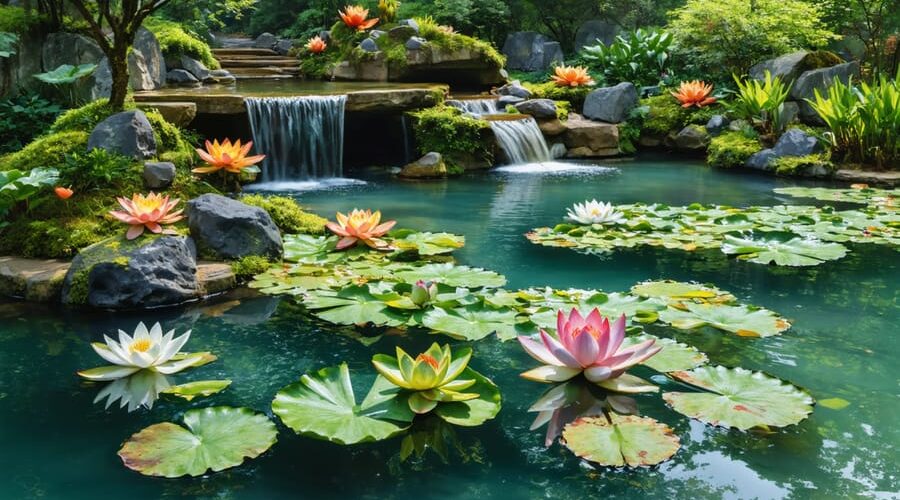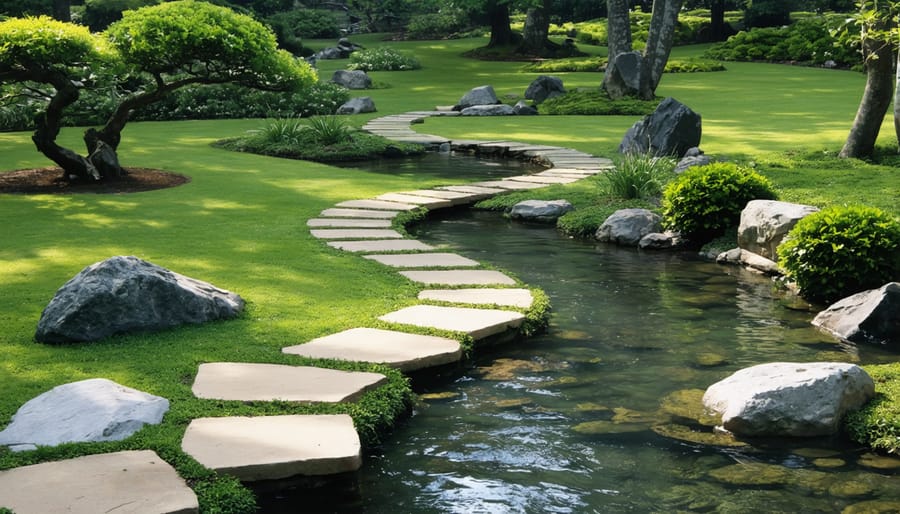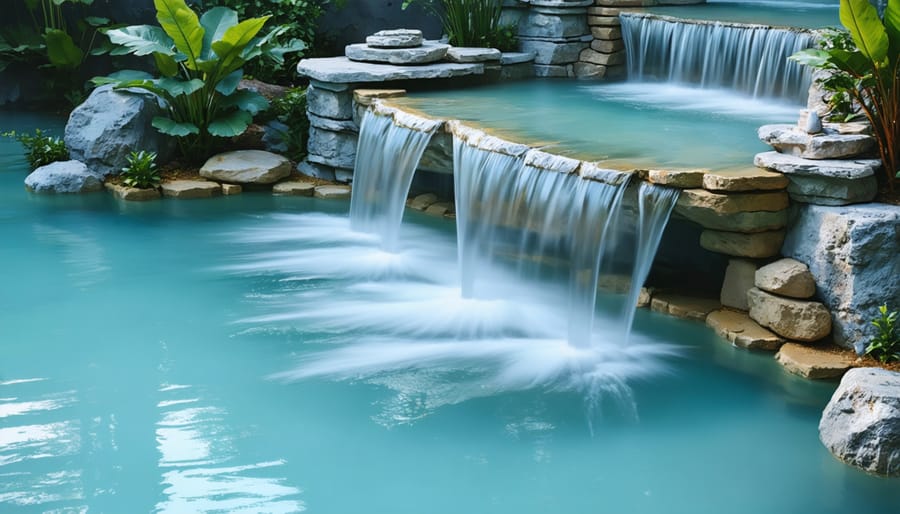
Transform Your Water Garden into Living Art: The Elements that Make it Magical
Transform your outdoor space into a living canvas by mastering the 7 fundamental elements of art – line, shape, form, space, color, texture, and value. These timeless principles, originally developed by master artists, bring the same powerful visual impact to water garden design as they do to classic paintings and sculptures. Whether you’re creating a tranquil spiritual garden sanctuary or a dramatic aquatic focal point, understanding these elements unlocks endless creative possibilities. By learning to manipulate these basic building blocks, you’ll develop the confidence to compose stunning water features that engage the senses and create lasting emotional connections with your outdoor space. Let’s explore how each element contributes to the artistry of water gardening, turning technical concepts into practical design wisdom you can apply immediately.
Line: Creating Flow and Movement
Natural vs. Architectural Lines
Nature’s flowing lines and architectural geometry create a fascinating interplay in water garden design. While natural streams and waterfalls follow organic, curved patterns that mimic the gentle meanders found in nature, geometric pond shapes introduce a striking contrast through clean, deliberate lines. This dynamic tension between natural and constructed elements is particularly evident in Japanese water garden design, where carefully planned angles meet soft, flowing elements.
When designing your pond, consider how curved edges can create a sense of movement and tranquility, while geometric shapes add structure and visual interest. A meandering stream might wind its way into a rectangular reflection pool, or a circular pond could feature organic plantings along its edges. This balance between natural and architectural lines helps create a harmonious space that feels both designed and organic, giving your water garden a sophisticated yet welcoming atmosphere.

Line in Water Features
Lines created by moving water add a captivating dynamic element to any water feature. A cascading waterfall creates strong vertical lines that draw the eye downward, while meandering streams form gentle curves that guide visitors through your garden space. The way water flows over rocks and ledges can create multiple line patterns – from bold, straight drops to subtle, rippling diagonals.
Consider incorporating stepped waterfalls for a series of horizontal lines that create visual rhythm, or design a curved stream bed that flows naturally around garden features. The movement of water itself forms temporary lines through ripples and splashes, adding an ever-changing artistic element to your landscape.
For maximum impact, try combining different water flow patterns. A straight-drop waterfall feeding into a winding stream creates an interesting contrast of line styles. Even small features like water blades or spouts can contribute crisp, architectural lines that complement your garden’s overall design.
Shape and Form: The Building Blocks
Organic Shapes in Nature
Nature is the ultimate artist, creating endless variations of organic shapes that inspire and delight. In your water garden, you’ll find these natural forms everywhere – from the gentle curves of lily pads to the irregular outlines of rocks. These organic shapes help create a balanced water garden ecosystem that feels authentic and harmonious.
Look closely at your garden’s plants, and you’ll notice how no two leaves are exactly alike. Each stem bends uniquely, each flower unfolds in its own way. Even the ripples on your pond’s surface create ever-changing organic patterns. Natural rock arrangements showcase these organic shapes beautifully – their weathered edges and uneven surfaces add character and visual interest.
When incorporating organic shapes into your water garden, try to mimic nature’s flowing lines. Allow plants to grow naturally rather than pruning them into rigid forms. Position rocks in groups that look as if they’ve always been there, avoiding straight lines or perfect circles. These natural forms will make your garden feel more peaceful and inviting, creating a space that connects deeply with the natural world.
Architectural Forms
Architectural forms in water gardens bring structure and human-made elements into your natural oasis. These designed features include fountains, bridges, pergolas, and decorative walls that add visual interest and functionality to your space. When incorporating architectural elements, consider how they complement your water feature’s natural flow and existing landscape.
A well-placed stone bridge creates a focal point while providing practical access across your pond. Pergolas offer vertical interest and create intimate seating areas where you can enjoy your water garden from a different perspective. Fountains aren’t just beautiful – they add soothing sounds and help aerate your pond water.
The key is finding the right balance between natural and constructed elements. Your architectural features should enhance, not overshadow, the organic beauty of your water garden. Consider using materials that echo your home’s architecture or complement local stonework. Natural materials like wood, stone, and metal weather beautifully and blend seamlessly with the surrounding landscape.
Start small with a simple fountain or decorative container, then gradually add larger architectural elements as your garden evolves. This approach helps you develop a cohesive design that feels both intentional and organic.
Color: Painting with Nature
Water-Reflective Colors
Water has a remarkable ability to transform and enhance colors in your garden through its reflective properties. Like nature’s mirror, water surfaces create stunning visual effects by doubling the impact of surrounding colors and adding depth to your landscape. In reflecting pools and garden ponds, colors appear more vibrant and intense due to the way light interacts with the water’s surface.
During different times of day, water reflects and amplifies colors differently. Morning light creates soft, pastel reflections, while midday sun produces bold, clear mirror images. The evening’s golden hour bathes reflected colors in warm, rich tones that add drama to your water feature.
Water also affects how we perceive color depth. Dark-colored elements appear deeper when reflected in water, while light colors seem to float on the surface. This natural phenomenon can be used to create illusions of space and depth in your garden design. Even the smallest ripples can break up color reflections into dancing patterns, adding movement and life to your outdoor space.
Consider positioning colorful plants, sculptures, or lighting near your water feature to maximize these reflective properties and create stunning visual displays throughout the day.

Seasonal Color Planning
Creating a visually engaging water garden throughout the year requires thoughtful color planning for each season. In spring, incorporate early-blooming plants like marsh marigolds and iris for bright yellows and purples. Summer brings the widest palette options, with water lilies offering pinks, whites, and deep reds, while lotus flowers provide dramatic focal points.
For autumn interest, consider plants with colorful foliage like Japanese maples near the pond’s edge, which offer brilliant oranges and reds. Hardy marginal plants like sedges and rushes maintain their structure and provide subtle green or bronze tones during winter months.
Layer your plantings with different bloom times in mind. Early spring bulbs can give way to summer perennials, followed by late-season grasses and seed heads. Include evergreen elements like mondo grass or certain sedums for year-round color structure. Don’t forget about hardscape elements – colored stones, ceramic pots, or painted features can provide constant color even when plants are dormant.
Remember that water itself reflects and enhances colors, making even subtle plant choices more impactful in your water garden setting.
Texture: Adding Depth and Interest
Contrasting Textures
The interplay between smooth and rough textures creates captivating visual interest in water garden designs. Water naturally provides a glossy, mirror-like surface that contrasts beautifully with coarse elements like natural stone, weathered boulders, or textured concrete. This juxtaposition draws the eye and creates depth in your garden space.
Consider placing rough-hewn granite blocks alongside a tranquil pond surface, or installing a cascading waterfall where tumbling water meets rugged rock faces. Even simple additions like placing smooth river rocks next to coarse gravel can create engaging textural variations. For maximum impact, try incorporating different surface treatments in close proximity – perhaps a sleek concrete border meeting natural stone steps that descend into the water.
The contrast between textures becomes even more dramatic when wet surfaces catch the light, making rough areas appear more pronounced while smooth areas gleam. This natural enhancement adds another dimension to your garden’s visual appeal throughout the day.

Plant Textures
Plant textures add depth and visual interest to any artistic composition, creating a rich tapestry of tactile experiences. From the smooth, waxy surfaces of tropical leaves to the delicate, lacy patterns of ferns, plants offer an incredible range of textural possibilities. Soft, fuzzy lamb’s ear contrasts beautifully with spiky ornamental grasses, while the rippled edges of coral bells create a different textural dimension altogether. When planning your garden or artwork, consider mixing fine-textured plants like Japanese maple leaves with bold, coarse textures like elephant ears. The interplay between rough bark, velvety flower petals, and glossy leaves can create dynamic visual tension. Layer these textures at different heights and depths to create a more engaging composition. Remember that texture changes with light and shadow, making your artistic creation different throughout the day as sunlight plays across various surfaces.
Space: Creating Depth and Perspective
Space in water garden design is all about creating a sense of depth and visual interest through careful placement of elements. Think of your water garden as a three-dimensional canvas where each layer contributes to the overall perspective. The foreground, middle ground, and background work together to draw the eye through the space.
Start by establishing different height levels in your water garden. Place taller plants and features like bamboo or ornamental grasses toward the back, medium-height elements like flowering water lilies in the middle, and low-growing marginal plants in the front. This creates a natural progression that leads the viewer’s eye through the garden.
Consider using the rule of thirds when planning your layout. Divide your water garden space into a grid of nine equal sections, and place key focal points where these lines intersect. This technique helps create balance while maintaining visual interest. For smaller gardens, use mirrors or reflective surfaces to create the illusion of more space.
Depth perception can be enhanced by incorporating stepping stones or a meandering path around your water feature. These elements invite exploration and make the space feel larger. Use overlapping elements, like placing rocks or plants partially in front of each other, to create a sense of distance and dimension.
Color also plays a role in spatial relationships. Lighter colors appear to recede, while darker colors come forward. Use this principle to your advantage by placing lighter-colored plants in the background and bolder, darker specimens in the foreground to enhance depth perception.
Remember to leave some open space – not every area needs to be filled. Empty spaces allow the eye to rest and make the occupied areas more impactful.
Value: Light and Shadow Play
Value in art refers to the lightness or darkness of colors, and in water gardens, this element creates dramatic effects through light and shadow play. As sunlight moves across your water garden throughout the day, it creates an ever-changing display of highlights and shadows that bring depth and dimension to your space.
Natural light interacts with water in fascinating ways, creating sparkles on rippling surfaces during bright daylight and subtle glows during dawn and dusk. The reflection of sunlight on water can illuminate surrounding plants and features, while shadows cast by tall grasses or decorative elements add mystery and visual interest.
To maximize the impact of value in your water garden, consider strategically placing plants and hardscape elements. Tall plants like papyrus or cattails can cast interesting shadows across the water’s surface, while floating plants like water lilies create patches of darkness that contrast beautifully with sunlit areas.
The depth of your pond also plays a role in value variation. Deeper areas appear darker, while shallow sections reflect more light, creating natural contrast. You can enhance these effects by incorporating underwater lighting, which adds an entirely new dimension to your garden after sunset.
Consider the surrounding environment too. Light-colored rocks or pale flowers near the water’s edge can reflect light onto the water surface, while darker elements like slate or deep-green foliage create dramatic shadows. This interplay of light and dark adds visual complexity and keeps your water garden interesting throughout the day.
Pattern: Bringing It All Together
Pattern brings together all the elements we’ve discussed, creating a harmonious and visually pleasing water garden design. It’s like conducting an orchestra where every element plays its part in perfect rhythm. By strategically repeating shapes, colors, and textures throughout your water garden, you create a sense of unity that guides the eye naturally through the space.
Think of pattern as your garden’s rhythm – the way plants, rocks, and water features echo each other across the landscape. You might repeat the same type of water lily in different parts of your pond, or arrange stepping stones in a consistent sequence. Even incorporating mythical garden elements can create meaningful patterns that tell a story through your design.
The key to successful pattern use is finding the right balance. Too much repetition can feel monotonous, while too little can make your garden feel chaotic. Try creating mini-patterns within larger ones – perhaps a series of small rocks leading to larger boulders, or delicate ground cover plants that complement taller aquatic species.
Remember, patterns don’t always need to be obvious. Sometimes the subtlest arrangements can create the most impactful designs, like the gentle ripples on your pond’s surface reflecting the organized chaos of nature itself.
Creating a harmonious water garden design is like conducting an orchestra where each element plays its vital role. By thoughtfully combining line, shape, form, space, color, texture, and value, you can create a stunning aquatic sanctuary that delights the senses and soothes the soul.
Start by sketching your basic layout using flowing lines to guide movement and create visual interest. Layer different shapes through plant choices and hardscaping elements, ensuring they complement rather than compete with each other. Consider how three-dimensional forms like rocks, statuary, or raised planters will interact with the surrounding space, both positive and negative.
Color selection should reflect your desired mood – cool blues and purples for tranquility, or vibrant yellows and reds for energy. Incorporate various textures through plant foliage, stone selections, and water features to add depth and interest. Finally, pay attention to value contrasts between light and dark elements to create visual drama and balance.
Remember, successful water garden design isn’t about using every element equally, but rather finding the right balance that works for your space and style. Take time to observe how these elements interact throughout different times of day and seasons, making adjustments as your garden grows and evolves.
